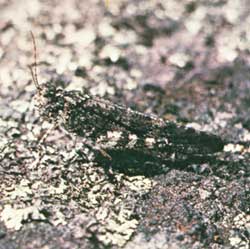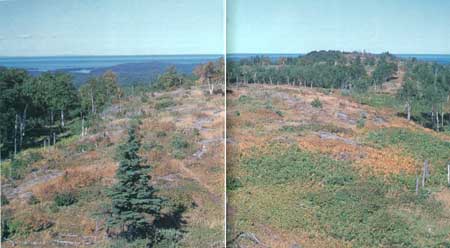|
ISLE ROYALE National Park |
 |
The Sparrow Hawk: Open Ridges
Even at 6 o'clock this early August morning, the sun is hot on Greenstone Ridge. Rising red above Lake Superior it sends its rays unopposed against the open, rocky slopes, further drying the grasses and slowing the activity of animals.
But though it is hot on the open ridge east of Mt. Ojibway, there is some action. Perched in a hazelnut thicket, a song sparrow sings. In another thicket, a red squirrel rustles, searching for curve-beaked hazelnuts. Atop yet another, a Traill's flycatcher gives its short little call, advertising its territory, though its young and those of other flycatchers are on the wing and wandering. In the Greenstone Trail between two thickets a snowshoe hare nips wild strawberry leaves. Far down the slope, a red fox picks its way between the shrubs, alert for hare, bird, or mouse; if unsuccessful, it will descend into the forest for wild sarsaparilla berries—a never-failing resource this time of year.

(Photo by J. Wiessinger)
At the tip of a dark spruce tree, a young sparrow hawk perches awkwardly, crying for food. But the hawk's parents are busy hunting. The trim female sits on the limb of a dead aspen, studying the ground. Her sharp eyes scan the rocks, grey-green with lichens and crevice-lined with grass and bush honeysuckle. Out of the grey-green-brown background she discerns an interesting shape. She plummets to the rock and seizes a grasshopper in her talons, then returns to her perch. Seeing all this, the young bird flutters to the aspen, but approaching the limb too fast can't hold on and pitches forward. It circles around, and on the second try manages to land. The mother bird rewards it with a mangled grasshopper.
 Grasshoppers, along with mice, are favored prey of the sparrow hawk. (Photo by Wm. Dunmire) |
The male sparrow hawk cruises above the ridge toward the fire tower, now flapping, now gliding, now hovering to inspect something below. He sees many things, but not all are significant to him. In a thicket of red maple, juneberry, and hazelnut a dark brown shape resolves into a bull moose intent on getting a last few mouthfuls before the heat drives him down into the forest. Across the trail, an oval depression remains in the grass where the bull slept part of the night. Farther along, the hawk sees two sharp-tailed grouse pecking at flower buds, berries, and insects. The grouse, too, will soon seek shade. Briefly, the sparrow hawk slows in his flight as he passes over a family of flickers stabbing the ground for ants, a cedar waxwing flycatching in the air, a robin caroling one last time this morning. But these are all too big for the hawk. He speeds on, searching for a sparrow, warbler, grasshopper, deer mouse, or red-bellied snake.
Then a dark shadow crosses the ground. The sparrow hawk looks up, climbs, then dives on the much larger red-tailed hawk. The redtail evades the rush and hastens on, eager to be free of its small tormentor. The sparrow hawk pursues it as far as the fire tower, then turns and glides back toward his family. The sun highlights the reds and blues on his back and wings.
Far out and below the sun, white cottony fog creeps across the surface of the lake. Soon it will envelop the island, blotting out the ridges and valleys, the lakes, the forest. Today fog, tomorrow wind, next week a storm will interrupt the heat that prevails on the summer ridges.
This piece of Greenstone Ridge is one of the larger open areas on Isle Royale. Similar openings occur frequently on other parts of Greenstone Ridge and on Minong and Feldtmann Ridges, with small patches scattered elsewhere. Generally, these nonforested strips are the result of fire aided by erosion and drought. Ridgetops, being the highest land on the island, frequently are hit by lightning, which sometimes starts fires. After a fire, the denuded soil is easily eroded. On any slope, erosion continually occurs on a small scale, but the lower parts also continually receive soil from upslope. On a ridgetop, of course, there is no higher source. Here, creation of new soil must proceed faster than erosion in order to make any headway. Organic debris is the principal building material of soil on ridges, but vegetation is discouraged by the thinness of the soils and the dryness caused by steep slopes, sun-heating, and wind. If plant succession does proceed toward forest, fire promoted by the dryness may at any time set it back. Thus, the ecologic dog has itself by the tail, and some stretches of ridgetop may remain open for many years.

(Photo by R. Janke)
The plantlife on open ridgetops is mainly that characteristic of early stages of succession, as described in chapter seven. Such places are usually a patchwork of bare rock, grassy areas with small shrubs such as blueberry and bush honeysuckle, shrubby thickets of hazelnut, juneberry, and sometimes young red and sugar maples, and scattered trees representative of the surrounding forest.
The animal life is also distinctive, and some species are restricted to such open areas. The larger animals are those found throughout the island. Moose most often visit the open ridges in early spring, when some herbaceous plants are sprouting and two favored shrubs, hazelnut and juneberry, are leafing. Hares enjoy the abundant low growth throughout the year but particularly in the green seasons. Wolves take advantage of the easy traveling on ridges, turning aside when a moose is started. Red foxes hunt fruits as well as live prey. Red squirrels sometimes visit the thickets, apparently for their seeds and fruits.
On the other hand, many of the birds of open ridges are pretty much restricted to this type of habitat. Sparrow hawks, which rely heavily on large insects such as grasshoppers, are typical inhabitants, often nesting in old flicker holes in dead white pines. Chipping sparrows, bluebirds, starlings, robins, cedar waxwings, and chestnut-sided, mourning, and Nashville warblers also favor this kind of environment.
The sharp-tailed grouse, though uncommon, is perhaps the most typical bird of this environment. These large, grey-brown birds with short, pointed, white-fringed tails would disappear if forest claimed the entire island. Though good habitat for them is available, their presence on the island is still something of a mystery. The other grouse of the mainland—ruffed and spruce grouse—have not been able to colonize the island because they can't make flights of more than a half-mile or so. How did the sharp-tailed grouse manage it? Possibly it was introduced by islanders of the past who wanted a game bird to hunt. More likely, the sharp-tail, a stronger flier than the other grouse, came under its own power, alternately sailing and beating its short, rounded wings.
Isle Royale's ridgetops thus offer the hiker the opportunity to explore a distinctive environment in all stages of plant succession from bare rock to mature forest. He will enjoy wild strawberries in early summer and blueberries in late summer, as well as incomparable views of the island, the big lake, and the mainland hills; and he will experience the ever-changing weather that presides over all.

|

|
|
|
|
Last Modified: Sat, Nov 4 2006 10:00:00 pm PST |


